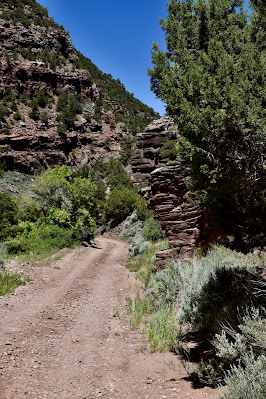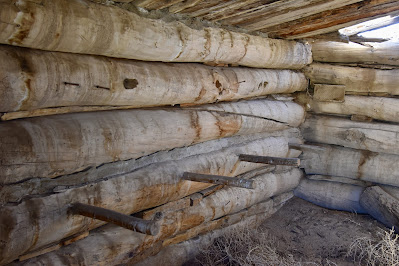Going back in time on the Green in Browns Park
What to do for our final full day sans family at Vernal - too many choices, so we flipped a mental coin and it landed on a loop drive through Browns Park in Colorado. As we set off on our auto tour with informative stops listed in a brochure, we acted as if we were civilized folks and not the ones who wander off willy-nilly at the slightest whim.
Crouse Canyon, our booklet informed us, is narrow and precipitous, and it did not lie. Somewhat trepidatiously, we obediently motored through the chasm, stopping occasionally to take photos that don't begin to convey the feeling created by those unstable-appearing shale shelves looming over us.
Most of the way was brightened by the sunny green of box elders lining both sides of the road and along the creek.
As we emerged, Browns Park spread before us in welcome contrast to the canyon confinement.
Speaking of narrow, the crossing of the Green there is via a swinging suspension bridge that accommodates only one vehicle at a time. Even with that, we folded in our side mirrors to fit. I held my breath as we crossed, which of course helps immensely in cases like that.
We walked out onto it before trusting it with the truck. When I saw the two cables that were holding the contraption up, it did not boost my confidence, but we trusted the engineers and workmen who put the thing in place, and hoped that they had not been impaired during the process. The span was constructed in 1954 to replace the 1927 swinging bridge built by Stanley Crouse (of Crouse Canyon "fame"), a contrivance that allowed movement of livestock, people & vehicles until deterioration and high winds blew boards off the bridge deck.
Once out of the canyon and across the bridge, I relaxed and savored the beauty of the Green. It somehow conveys to me a sense of confidence and self; it remains one of my favorite rivers.
Following the guide book worked for a while: we enjoyed seeing new and interesting territory and learning about it as we went; however, there came a time when the siren call of “fomo” interfered. I just learned the term from Shannon, and found it a perfect fit: “Fear of missing out”.
It was that turnoff that did it: “Wildlife drive” it invited. The decision was quickly made, and we were off. What a beautiful and fascinating drive it turned out to be as we wound along with the Green River’s meanderings.
Many wetland areas infill the river's meanders; they are utilized by migrating birds, but there was little waterfowl while we were there, except for one spot where we saw mallard, cinnamon teal, ruddy duck, redhead, ring-necked duck, pied-billed grebe & red-winged blackbird. Prior additions to the trip list include great blue heron, osprey, common grackle, Canada goose, western bluebird, western kingbird & kestrel.
In the early 1800s, American fur trappers & mountain men were at work in the West, and the lush Browns Park valley was rich with resources. They were followed by cattlemen who wintered their stock there, said to number as many as 100,000 cattle before ranches were established.
The arrival of ranchers in the isolated region coincided with outlaws who found it a convenient hideaway from the law after their robberies of trains and banks. Among the criminal class there was the notorious Butch Cassidy and his cohorts.
The lack of law enforcement there led to much cattle rustling among all the ranchers; that included Herb & Mary Elizabeth Bassett, parents of Josie & Ann, who was born in 1878, the first white child born in Browns Park. The family were friendly with the so-called Wild Bunch. As time went on and the two sisters ran their own ranches, they were involved in some amount of rustling themselves, occasionally charged but never convicted.
When we spotted a historic site, the Two Bar Ranch, on a map, one of us was certain that it had been Ann Bassett's spread, but one of us differed with that opinion. Who thought what can be left unnoted; however, never let it be said that the señor is always right and I am always wrong.
Whoever the place belonged to, our interest was piqued. We were in the vicinity of it when we drove to the historic Lodore School . . .
. . . on the river very near to what a member of the Powell expedition called the Gates of Lodore, when they went through there in 1869, where the Green River has cut a magnificent canyon through the massive rock.
To shorten a long story, despite there being no road to the Two Bar, there was nothing for it once we had seen the buildings in the distance, but that we had to get there. Subsequent follow-up indicates the Two Bar was a rival ranch with Ann Bassett, but we have not discerned the location of her headquarters.
We began walking toward the Two Bar site far in the distance from the Lodore School. Unfortunately, it was total bushwhacking through sticker bushes, cactus and high dry grass, so I called a halt, hoping to find a better route.
Back to the dirt road we went, which got us a little closer and up out of the bottomland. From there we set off down a dry hillside, still bushwhacking but through slightly sparser vegetation. By that time later in the day, we had passed up a couple of cabin ruins back by the canyon and much more that we would like to have done, so a return visit is in order.
After the hard hot work getting to the ranch ruins, I was certain to photograph the place as thoroughly as time allowed. Much of the construction was from cottonwood logs; most had sod roofs.
This was a large bunkhouse: the upper bunks are visible on the left.
The interior of the root cellar was fascinating to me - large holes had been drilled into the log walls and cottonwood branches inserted, evidently to support shelves.
With satisfaction at having gotten to and explored the ruins of the Two Bar, we began our return to Vernal, arriving about 9 p.m. hot, hungry & exhausted, and determined to return for more exploration.


























No comments:
Post a Comment